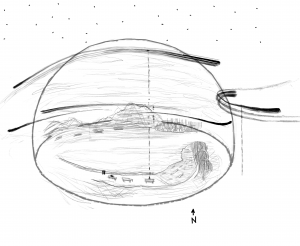In-Class Exercise
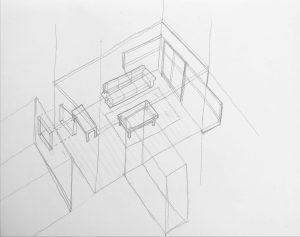
Assignment 2
1 & 2. Cube drawings

3. Cone drawings

4. Drawing at home object
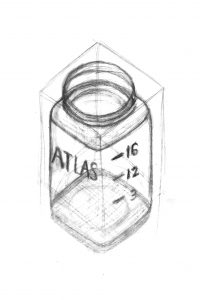
5 & 6. Timed drawings

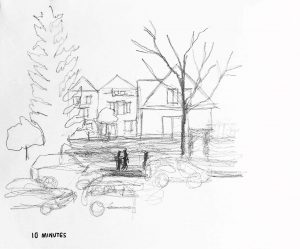
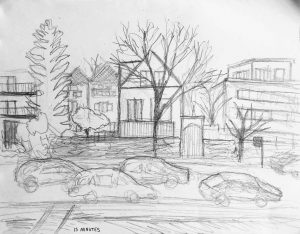
In-Class Exercise

Assignment 2
1 & 2. Cube drawings

3. Cone drawings

4. Drawing at home object

5 & 6. Timed drawings



Assignment 11

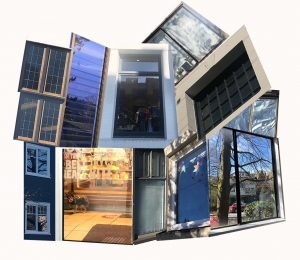

Looking at window typologies of buildings in Kitsilano and at the UBC campus. Studying their form, structure, colour and reflectivity through sketching and collage.
Windows tend to frame subject matter at different times of day and create moments of pause.
Summary Collage

This summary collage of the course expresses the learning of using drawing as a mode of communication to map sensory spatial experiences. Drawing gives one the freedom to manipulate scale and draw what can’t be seen; as journeys and experiences are interpreted and expressed uniquely from person to person.
In-Class Exercise (Granville Island field trip)
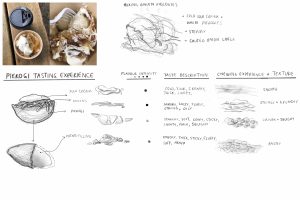
Deconstructing the pierogi eating experience.
Assignment 10

Reusable ice coffee cup design which slows down caffeine intake.
In-Class Exercise (Stanley Park field trip)
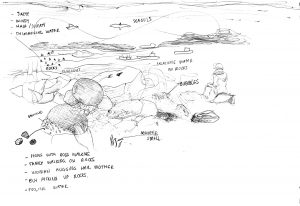
This drawing is an experiential analysis of visiting the shoreline in Stanley Park. This area of the park had a strong ocean salt smell. I had begun to depict more specific smells of this area by noticing micro habitat such as seaweed and mussels. These had stronger salty fishier smells to them.
Assignment 9
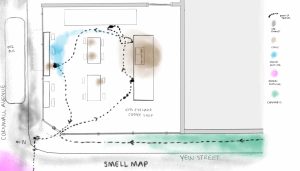
I recorded smells I observed on my visit to the coffee shop at the southeast corner of Cornwall and Yew in Kitsilano. I mapped 5 powerful smells that were big parts of my journey and experience. I often go to this coffee shop and experience the familiar smell of walking by the cannabis shop, and of course the smell of coffee when entering the coffee shop. However a person with heavy coconut smelling perfume sat beside me and their scent would fill the air around me every time they moved or repositioned themselves. This was a very strong smell that overpowered the coffee smell at that area of the shop. Smells that I had realized I didn’t notice before were the smells of the exhaust of the heavy car traffic and the 002 Downtown bus that makes frequent stops in front of the shop. Mapping these scents in plan view was significant in how I recalled how I felt when positioning myself in different areas where each scent was present. This analysis also conveyed to me how a static urban spaces can still hold dynamic experiences.
In-Class Exercise
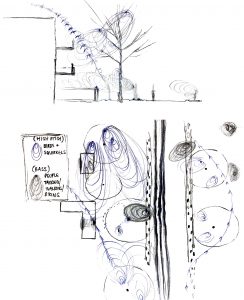
In this exercise I observed sounds from my balcony. My method of representation uses black to show sounds with bass (People talking, walking, and biking) and blue to show sounds with higher pitches (chirping birds and the rattling and rustling of squirrels). The location, paths, and radiation of these sounds are shown both in plan and section.
Assignment 8-
Tuning In

I sat at a bench at Kitsilano Beach Park and observed the sounds around me. I thought about each sound and tried to express its characteristics through lines and how I experienced them traveling into my ear. The loudest sounds were the crashing waves of the water which is expressed in back and forth movement, getting noisier when crashing into a wall or the sand at the shore. The airplane above was loud, but not as crisp of a sound compared to the water. The airplane sound lines are shown as very blurry and dense. Similar distant sounds were the trees and vehicle traffic happening behind me, which are shown as a background noise which was not as overwhelming and distinguishable. The sounds of people walking, talking, running, and biking on the path were significantly dynamic and quickly paced. For example, the sound of a bike zipping by was louder as it approached and became quit immediately when it left. Its closeness allowed me to hear the sound of the tire rubber rolling on damp asphalt. The path of the tires and their rolling shape show their presence in my hearing experience, as the bottoms of the tires are darkened to show their unique sounds when making contact with the wet ground. The sounds of dogs running on the beach were faint, as the small movement of sand from their paws are represented with faint sand-like dots.
Wind Play
I created a wind-play object from plastic. Cutting equally sized strips and tying them together, I formed three long strips. After observing how they behaved in the wind, I was surprised to how the weight of the knots changed the way each strip swayed in the wind. The contrast between the three strips created a dancing effect, as each strip uniquely wiggled but still followed the same motion and direction of the other. The structured fluidity of the object’s movements reminded me of an octopus and its tentacles moving underwater. I learned from creating this object that wind energy plays an important role in not only natural occurring forms and patterns, but how vegetation and habitat behave and move. How can we design so wind can be “seen” or manipulated in the landscape?
In-Class Exercise
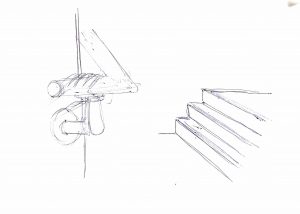
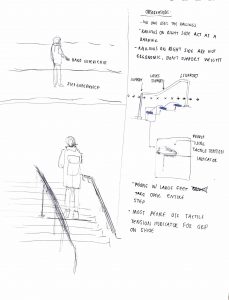

Assignment 7
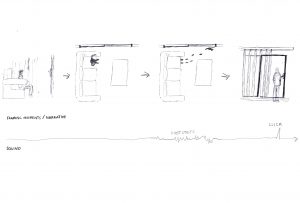
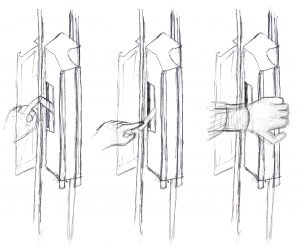
In-Class Exercise
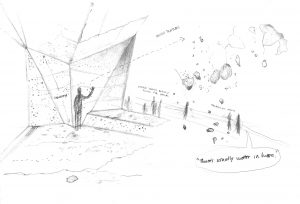
Observing the form and texture of the water feature pavilion and movement at the adjacent path.
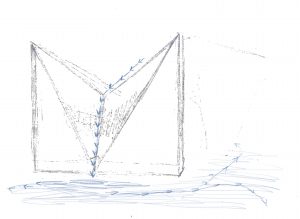

Assignment 6

Observing the landscape around my building and the materiality after it rained.
This sketch conveys the way paths are constructed character of damp concrete, wood, and vegetation.
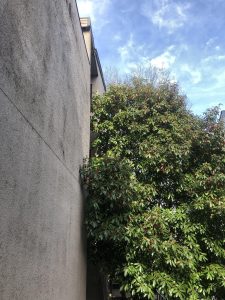

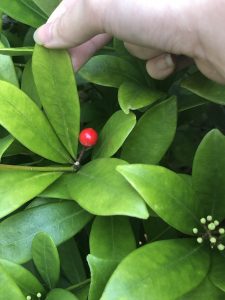
In-Class Exercise
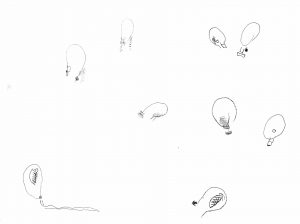
Blind-folded drawing of white-out

(Blind-folded drawing on left, drawing without blindfold off on right)
Assignment 5
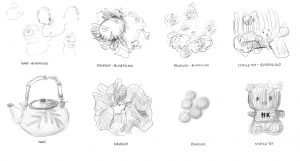
(Blind-folded drawing on top, drawing without blindfold at the bottom)
In-class Exercise
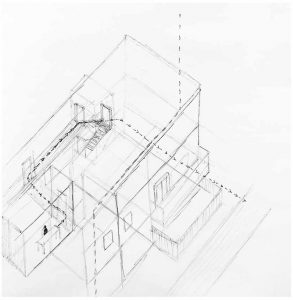
Communicating how to get to street from office closet, while beginning to map rainwater.
Assignment 4
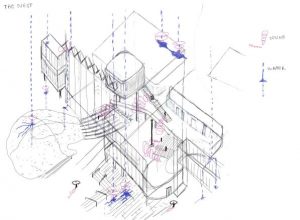
Analyzing sound and water at the Nest.
In-class exercise
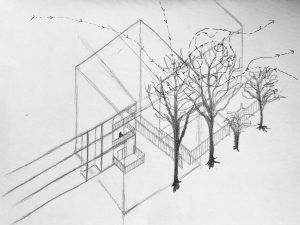
I mapped airplanes at Kitsilano Beach Tuesday Evening. Sitting on a bench, I observed several planes and their paths in the span of 30 minutes. The most significant planes I noticed first were the ones that flew directly overhead. They were only minutes apart on the same path and direction. For 10 minutes I spotted no planes until another group of planes came from the opposite direction on another path. During this time I also spotted planes north of the mountains that ran east and west.
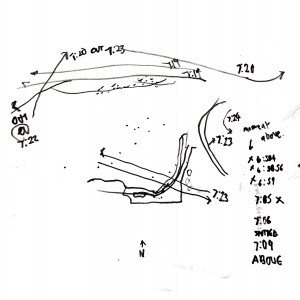
In this map I try to achieve the plane paths and their movement in the sky. Using thick lines, the pressure of lines show the direction of the path and a sense of time (I thought about jets during the day that leave vanishing smoke paths). I also tried to convey the auditory experience of the planes by showing clearer and heavier lines for the paths nearest to me. I thought the use of a dome rather than a cube would better show my site experience because it was dark out and the landscape, water, and shoreline were the only clear reference points to map out the plane’s location in the atmosphere (showing sense of plane path location with vertical dotted lines).
